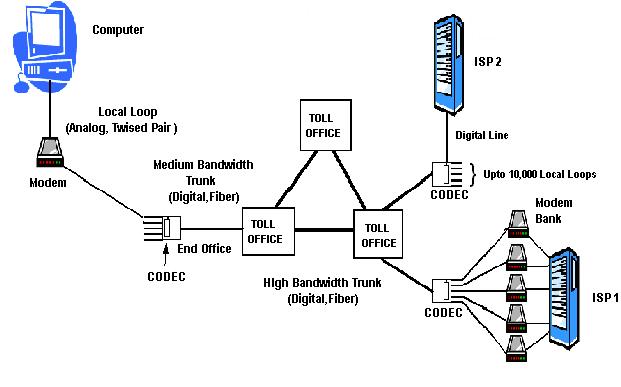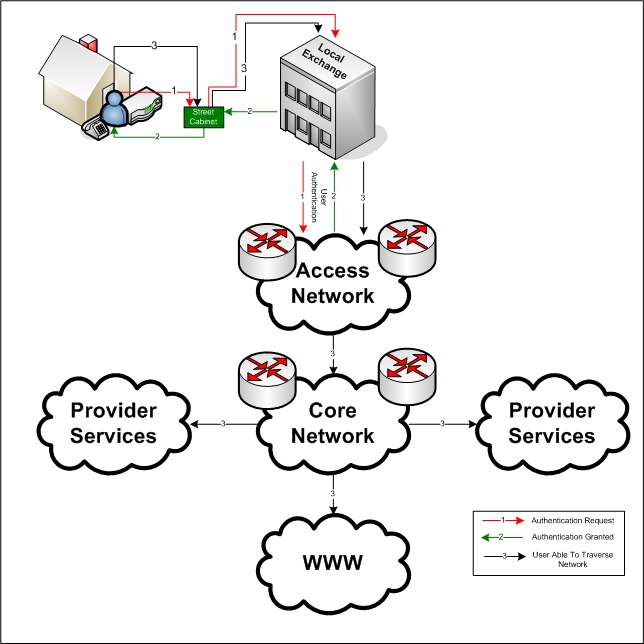 |
Local Loop
In telephony, the local loop (also referred to as the local tail, subscriber line, or in the aggregate as the last mile) is the physical link or circuit that connects from the demarcation point of the customer premises to the edge of the common carrier or telecommunications service provider's network. At the edge of the carrier access network in a traditional public telephone network, the local loop terminates in a circuit switch housed in an incumbent local exchange carrier or telephone exchange. Infrastructure Traditionally, the local loop was an electrical circuit in the form of a single pair of conductors from the telephone on the customer's premises to the local telephone exchange. Single-wire earth return lines had been used in some countries until the introduction of electric tramways from the 1900s made them unusable. Historically the first section was often an aerial open-wire line, with several conductors attached to porcelain insulators on cross-arms on "te ... [...More Info...] [...Related Items...] OR: [Wikipedia] [Google] [Baidu] |
|
Competitive Local Exchange Carrier
A competitive local exchange carrier (CLEC) is a North American telecommunications provider classification that emerged based on the competition model of the Telecommunications Act of 1996 in the United States. The act required the previously established incumbent local exchange carrier (ILEC) in each local market to provide infrastructure hosting and services to CLECs to enable competition with the ILEC. Background Local exchange carriers (LECs) are characterized as incumbent (ILECs) or competitive (CLECs). The ILECs are usually the original, monopoly LEC in a given area, and receive different regulatory treatment from the newer CLECs. A data local exchange carrier (DLEC) is a CLEC specializing in DSL services by leasing lines from the ILEC and reselling them to Internet service providers (ISPs). History CLECs evolved from the competitive access providers (CAPs) that began to offer private line and special access services in competition with the ILECs beginning in 1985. The CA ... [...More Info...] [...Related Items...] OR: [Wikipedia] [Google] [Baidu] |
|
|
Metallic Path Facilities
Metallic path facility (MPF) are the unshielded twisted pair of copper wires that run from a main distribution frame (MDF) at a local telephone exchange to the customer. In this variant, both broadband and voice (''baseband'') services, together potentially with a video on demand service, are provided to the end user by a single communications provider. MPF services are typically delivered through use of an MSAN. Shared metallic path facility (SMPF) is based on the same technology as MPF, but denotes a variant whereby an Internet Service Provider (ISP) provides a broadband service to the end user but hands the voice (''baseband'') service back to the PTT/ ILEC. Hence the provision of services over the end users copper wires might be shared between two providers. With SMPF, the non-incumbent service provider could purchase wholesale the voice service provision from the PTT/ILEC to allow the former to control the customer relationship for both broadband and voice services. In the ... [...More Info...] [...Related Items...] OR: [Wikipedia] [Google] [Baidu] |
|
|
Local-loop Unbundling
Local loop unbundling (LLU or LLUB) is the regulatory process of allowing multiple telecommunications operators to use connections from a telephone exchange to the customer's location. The physical wire connection between the local exchange and the customer is known as a "local loop" and is owned by the incumbent local exchange carrier (also referred to as the "ILEC", "local exchange", or in the United States, either a " Baby Bell" or an independent telephone company). To increase competition, other providers are granted unbundled access. Policy background LLU is generally opposed by ILECs, which are generally either former investor-owned (North America) or state-owned monopoly enterprises. ILECs argue that LLU amounts to regulatory taking, which causes them to be compelled to provide competitors with business inputs, so they believe that LLU stifles infrastructure-based competition and technical innovation because new entrants prefer to use the incumbent's network instead of b ... [...More Info...] [...Related Items...] OR: [Wikipedia] [Google] [Baidu] |
|
 |
ISDN
Integrated Services Digital Network (ISDN) is a set of communication standards for simultaneous digital transmission of voice, video, data, and other network services over the digitalised circuits of the public switched telephone network. Work on the standard began in 1980 at Bell Labs and was formally standardized in 1988 in the CCITT "Red Book". By the time the standard was released, newer networking systems with much greater speeds were available, and ISDN saw relatively little uptake in the wider market. One estimate suggests ISDN use peaked at a worldwide total of 25 million subscribers at a time when 1.3 billion analog lines were in use. ISDN has largely been replaced with digital subscriber line (DSL) systems of much higher performance. Prior to ISDN, the telephone system consisted of digital links like T1/ E1 on the long-distance lines between telephone company offices and analog signals on copper telephone wires to the customers, the " last mile". At the time, t ... [...More Info...] [...Related Items...] OR: [Wikipedia] [Google] [Baidu] |
 |
Access Network
An access network is a type of telecommunications telecommunications network, network which connects subscribers to their immediate telecommunications service provider, service provider. It is contrasted with the core network, which connects local providers to one another. The access network may be further divided between feeder plant or distribution network, and drop plant or edge network. Telephone heritage An access network, also referred to as an outside plant, refers to the series of wires, cables and equipment lying between a consumer/business telephone termination point (the point at which a telephone connection reaches the customer) and the local telephone exchange. The local exchange contains banks of automated switching equipment which direct a call or connection to the consumer. The access network is perhaps one of the oldest assets a telecoms operator would own. In 2007–2008 many telecommunication operators experienced increasing problems maintaining the quality ... [...More Info...] [...Related Items...] OR: [Wikipedia] [Google] [Baidu] |
 |
DECT
Digital Enhanced Cordless Telecommunications (DECT) is a cordless telephony standard maintained by ETSI. It originated in Europe, where it is the common standard, replacing earlier standards, such as CT1 and CT2. Since the DECT-2020 standard onwards, it also includes IoT communication. Beyond Europe, it has been adopted by Australia and most countries in Asia and South America. North American adoption was delayed by United States radio-frequency regulations. This forced development of a variation of DECT called DECT 6.0, using a slightly different frequency range, which makes these units incompatible with systems intended for use in other areas, even from the same manufacturer. DECT has almost completely replaced other standards in most countries where it is used, with the exception of North America. DECT was originally intended for fast roaming between networked base stations, and the first DECT product was Net3 wireless LAN. However, its most popular application is s ... [...More Info...] [...Related Items...] OR: [Wikipedia] [Google] [Baidu] |
 |
HSDPA
High Speed Packet Access (HSPA) is an amalgamation of two mobile protocols—High Speed Downlink Packet Access (HSDPA) and High Speed Uplink Packet Access (HSUPA)—that extends and improves the performance of existing 3G mobile telecommunication networks using the WCDMA protocols. A further-improved 3GPP standard called Evolved High Speed Packet Access (also known as HSPA+) was released late in 2008, with subsequent worldwide adoption beginning in 2010. The newer standard allows bit rates to reach as high as 337 Mbit/s in the downlink and 34 Mbit/s in the uplink; however, these speeds are rarely achieved in practice. Overview The first HSPA specifications supported increased peak data rates of up to 14 Mbit/s in the downlink and 5.76 Mbit/s in the uplink. They also reduced latency and provided up to five times more system capacity in the downlink and up to twice as much system capacity in the uplink compared with original WCDMA protocol. High Speed D ... [...More Info...] [...Related Items...] OR: [Wikipedia] [Google] [Baidu] |
 |
GPRS
General Packet Radio Service (GPRS), also called 2.5G, is a mobile data standard on the 2G cellular communication network's Global System for Mobile Communications, global system for mobile communications (GSM). Networks and mobile devices with GPRS started to roll out around the year 2001; it offered, for the first time on GSM networks, seamless data transmission using Packet switching, packet data for an "always-on" connection (eliminating the need to "dial-up"), so providing improved Internet access for World Wide Web, web, email, Wireless Application Protocol, WAP services, Multimedia Messaging Service (MMS) and others. Up until the rollout of GPRS, only circuit switched data was used in cellular networks, meaning that one or more radio channels were occupied for the entire duration of a data connection. On the other hand, on GPRS networks, data is broken into small packets and transmitted through available channels. This increased efficiency also gives it theoretical data ... [...More Info...] [...Related Items...] OR: [Wikipedia] [Google] [Baidu] |
|
WiMAX
Worldwide Interoperability for Microwave Access (WiMAX) is a family of wireless broadband communication standards based on the IEEE 802.16 set of standards, which provide physical layer (PHY) and media access control (MAC) options. The WiMAX Forum was formed in June 2001 to promote conformity and interoperability, including the definition of system profiles for commercial vendors. The forum describes WiMAX as "a standards-based technology enabling the delivery of last mile wireless broadband access as an alternative to cable and DSL". WiMAX was initially designed to provide 30 to 40 megabit-per-second data rates, with the 2011 update providing up to 1 Gbit/s for fixed stations. IEEE 802.16m or Wireless MAN-Advanced was a candidate for 4G, in competition with the LTE Advanced standard. WiMAX release 2.1, popularly branded as WiMAX 2+, is a backwards-compatible transition from previous WiMAX generations. It is compatible and interoperable with TD-LTE. Newer versions ... [...More Info...] [...Related Items...] OR: [Wikipedia] [Google] [Baidu] |
|
 |
Digital Subscriber Line
Digital subscriber line (DSL; originally digital subscriber loop) is a family of technologies that are used to transmit digital data over telephone lines. In telecommunications marketing, the term DSL is widely understood to mean asymmetric digital subscriber line (ADSL), the most commonly installed DSL technology, for Internet access. In ADSL, the data throughput in the upstream (networking), upstream direction (the direction to the service provider) is lower, hence the designation of ''asymmetric'' service. In symmetric digital subscriber line (SDSL) services, the downstream and upstream data rates are equal. DSL service can be delivered simultaneously with plain old telephone service, wired telephone service on the same telephone line since DSL uses higher frequency bands for data transmission. On the customer premises, a DSL filter is installed on each telephone to prevent undesirable interaction between DSL and telephone service. The bit rate of consumer ADSL services typ ... [...More Info...] [...Related Items...] OR: [Wikipedia] [Google] [Baidu] |